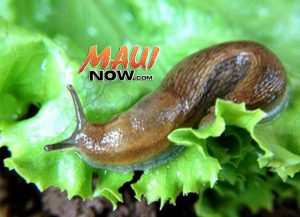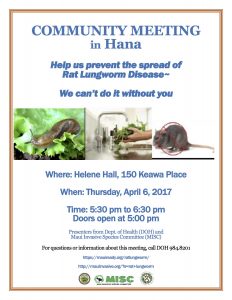UPDATE: Maui Woman Among Those Diagnosed with Rat Lungworm Disease
An update from Janice Okubo from the Hawaiʻi Department of Health told Maui Now via e-mail Wednesday evening that there are two confirmed Maui resident cases of rat lungworm and two non-resident cases with a history of travel to Maui. “In addition, four reported possible cases are under investigation and not confirmed,” she said.

Rat Lungworm can be caught from not properly washing produce. Photo Courtesy Maui Invasive Species Committee
It is still unclear where the possible cases caught the parasite but she did say, “This year, there has been one laboratory confirmed case of a Maui resident who traveled to Hawaiʻi Island for work.”
She said that Maui has a higher than normal number of possible cases under investigation and that it raises concern.
“In 2015 there were seven confirmed cases (statewide), this year there has been one case,” Okubo said. She added that there were at least four cases midway through 2016.
There will be a community meeting tonight, Thursday, April 6, in Hāna to educate the public about disease prevention. The meeting will take place at Helene Hall, 150 Keawa Place from 5:30 to 6:30 p.m. Doors will open at 5 p.m.
Presenters at the meeting include Maui District Health Officer Dr. Lorrin Pang and presenters from the Maui Invasive Species Committee.
Previous Post:
A recent case of a Maui woman contracting rat lungworm has brought attention to a disease that can be caught by eating from your yard.
The latest confirmed case is Tricia Mynar, 47, a Maui preschool teacher who believes she got the disease from eating a salad while on the Big Island, according to media reports.
While health officials can’t confirm how she got the disease, the Hawaiʻi Department of Health says there have been 58 recorded cases of rat lungworm and that most of the cases stem from Hawaiʻi Island.
A Hawaiʻi News Now report back in 2015 stated that 38 of the 42 then reported cases of ‘rat lungworm’ in Hawaiʻi since 2007 had happened on Hawaiʻi Island.

It is becoming such a concern that the there will be a community meeting Thursday, April 6, at 5 p.m. in Hāna to educate the public about disease prevention.
A report showed that the only previously confirmed case of a Maui resident contracting rat lungworm was back in 2010. After another case was confirmed in March, Health Department officials are looking into four more possible victims.
Rat lungworm or Angiostrongylus cantonensis is a parasite that mainly lives in rodents such as rats and can infect snails and slugs that come into contact with infected rat feces. People can be infected when they eat an infected snail or slug or from the slime trail left behind on food such as produce.
According to the DOH website, the rat lungworm can affect the brain and spinal cord. Symptoms may include severe headache, stiffness of the neck and back, skin tingling, pain and sensitivity, sensitivity to light, hallucinations, nausea, vomiting and sometimes coma and death.
Mynar told a news source that she felt symptoms back in February and explained having flu like symptoms followed by a ‘weird sensation’ in her right foot. She told Civil Beat that a week after her first symptoms occurred she had ‘pain all over my body, but especially on both sides of my spine.’
The only way to test for the disease is through a spinal tap and when Mynar’s tests came back positive, she was admitted and spent a week in the hospital.
There is currently no specific treatment for angiostrongyliasis. Patients fighting the disease are prescribed antibiotics for infection and morphine and oxycontin for pain.
Animals can also get rat lungworm. There was a report of a sloth at the Hilo Zoo that caught rat lungworm and became paralyzed in the hind legs. There have also been reports of people’s cats and horses contacting it too.
The DOH says foods such as raw produce, raw or undercooked snails, freshwater prawns, crabs and frogs can be contaminated by an unseen parasite Angiostrongylus cantonensis (rat lungworm). Fish are not known to carry this parasite.
To prevent rat lungworm disease the DOH says to:
– Avoid raw foods contaminated with the slime from snails or slugs or visible snail or slugs.
– Rinse produce in potable water completely, and boil snails, freshwater prawns, crabs, and frogs for at least 3-5 minutes.
– Do not handle snails and slugs with bare hands.
– Control slugs and snails at your residence.
– Cover your catchment tanks to prevent slugs and snails from having access.
– Controlling rodents can also help control the rat lungworm.










